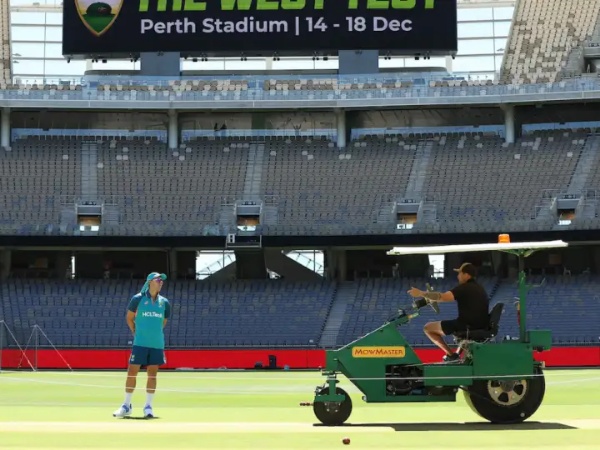views : 789
4 Min Read
Border Gavaskar Trophy: Australia vs India 1st Test, Perth pitch report
India is set for a challenging start to their Border Gavaskar Trophy (BGT) campaign as they prepare for the opening Test at Optus Stadium in Perth, where the pitch has been prepared to offer "good bounce and pace." This is in line with Perth's traditional reputation for fiery, fast tracks that often test the resilience and skills of visiting teams. The Test, which begins on November 22, will be crucial for both teams as they look to make a strong statement in the series. However, India will head into the match without any practice games. The visitors had initially scheduled an intra-squad match from November 15 to 17 but later decided to cancel it. With no warm-up match, India will focus on centre-wicket training sessions at the WACA ground, located nearby. These training sessions will serve as the team’s preparation for the Test series, offering them an opportunity to adapt to the Australian conditions.
Border Gavaskar Trophy: Western Australia curator opens up on the Perth Pitch report
Meanwhile, Australia will also be refining their skills at the WACA, ensuring they are fully prepared to face the challenges posed by the Indian side. The absence of a practice match might place India at a slight disadvantage, but the team management will be hoping that the centre-wicket sessions and their past experiences in Australian conditions will help them make the necessary adjustments ahead of the India vs Australia opening Test.
"This is Australia, this is Perth... I'm setting ourselves up for really good pace, really good bounce and really good carry," Western Australia Cricket head curator Isaac McDonald said in an interview.
Australia’s head coach Andrew McDonald is aiming to prepare a pitch for the opening Test against India that mirrors the one he curated for the first Test against Pakistan in December last year. In that match, the pitch played a significant role in Australia’s dominant 360-run victory. Pakistan was dismissed for just 89 in their second innings, with the cracks that developed on the surface as the match progressed playing a key role in the collapse.
Batters, including Australia’s Marnus Labuschagne, were frequently hit on the hands as the pitch offered unpredictable bounce and movement. McDonald’s goal is to replicate those conditions for the Border Gavaskar Trophy, with the intention of creating a fast, bouncy surface that could challenge the Indian batsmen. The cracks that developed last year, which affected batters’ ability to score and forced them to adapt quickly, are expected to be a feature of the pitch again. With both teams set to face a tough challenge, the pitch at Optus Stadium is sure to play a major role in the outcome of the opening Test. The bouncy, fast conditions will require precision and skill from both the batters and bowlers as they battle it out in Perth’s challenging conditions.
In the previous Test between Australia and Pakistan in December last year, the Australian pacers – Pat Cummins, Josh Hazlewood, and Mitchell Starc – played a pivotal role, taking 12 of the 20 Pakistan wickets. The pitch conditions, with cracks that developed throughout the game, gave the fast bowlers an edge, and the Australians made full use of it. However, in more recent times, the tables have turned, with Pakistan’s pacers – Shaheen Shah Afridi, Naseem Shah, and Haris Rauf – wreaking havoc on the Australian batting line-up. In the third ODI between the two teams, the Pakistan bowlers bowled Australia out for just 140 runs, showcasing their prowess in the face of challenging conditions.
Ahead of the Border-Gavaskar Trophy, Australian head coach Andrew McDonald has revealed his plans for the pitch at Optus Stadium. He intends to leave a little grass on the surface to make it “spicier,” ensuring that the conditions are favorable for fast bowlers. McDonald’s strategy is to replicate the challenging, bouncy conditions that were seen in the 2023 Test against Pakistan. With the Australian pacers in formidable form, the pitch is expected to provide a true test for both teams, especially India, who will face a different style of play compared to the flat wickets of the subcontinent. The match is shaping up to be a thrilling contest.
"It's (10 mm) a good starting point. Ten millimetres was pretty comfortable with the conditions that we had (last year) and that held the conditions together nicely for the first few days. Live grass on the pitch is speed. Both bowling units (Australia and Pakistan) were pretty rapid last year and hoping for much the same this year (for India match),” said Aussie head coach Andrew McDonald.
